#The Founding of the Ming Dynasty
Explore tagged Tumblr posts
Text
No, it's not Manda!
It's the Dragon That Just Appears To Fight Another Monster Then Disappears from The Fairy and the Devil (1982).
Although, as far as can tell, this footage is actually purloined from an earlier film, The Founding of the Ming Dynasty (1971).
#The Fairy and the Devil#dragon#Chinese mythology#Taiwanese cinema#The Founding of the Ming Dynasty#fantasy#practical effects#marionette#puppet
16 notes
·
View notes
Text

900 Artifacts From Ming Dynasty Shipwrecks Found in South China Sea
The trove of objects—including pottery, porcelain, shells and coins—was found roughly a mile below the surface.
Underwater archaeologists in China have recovered more than 900 artifacts from two merchant vessels that sank to the bottom of the South China Sea during the Ming dynasty.
The ships are located roughly a mile below the surface some 93 miles southeast of the island of Hainan, reports the South China Morning Post’s Kamun Lai. They are situated about 14 miles apart from one another.


During three phases over the past year, researchers hauled up 890 objects from the first vessel, including copper coins, pottery and porcelain, according to a statement from China’s National Cultural Heritage Administration (NCHA). That’s just a small fraction of the more than 10,000 items found at the site. Archaeologists suspect the vessel was transporting porcelain from Jingdezhen, China, when it sank.
The team recovered 38 items from the second ship, including shells, deer antlers, porcelain, pottery and ebony logs that likely originated from somewhere in the Indian Ocean.
Archaeologists think the ships operated during different parts of the Ming dynasty, which lasted from 1368 to 1644.

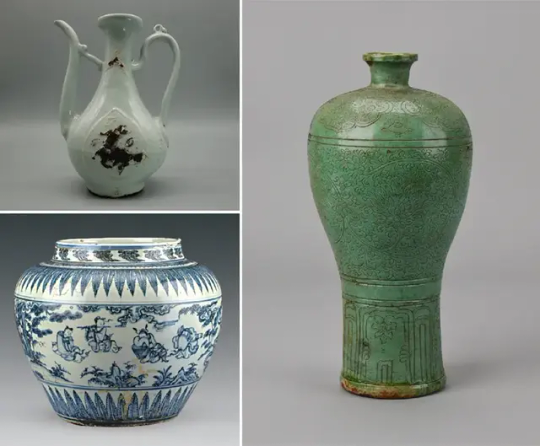
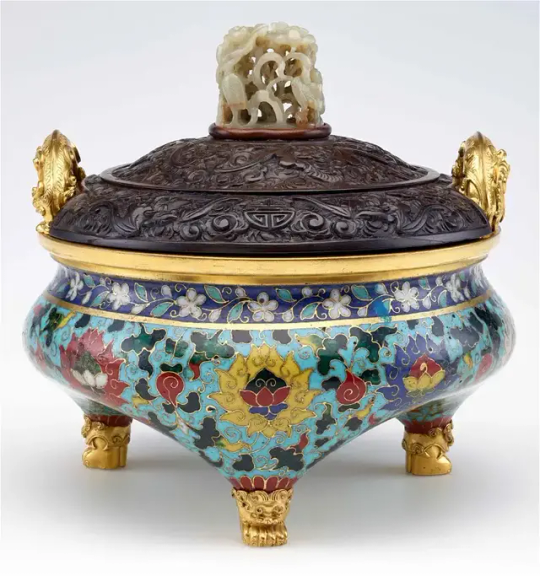
Many of the artifacts came from the Zhengde period of the Ming dynasty, which spanned 1505 to 1521. But others may be older, dating back to the time of Emperor Hongzhi, who reigned from 1487 to 1505, as Chris Oberholtz reported last year.
Archaeologists used manned and unmanned submersibles to collect the artifacts and gather sediment samples from the sea floor. They also documented the wreck sites with high-definition underwater cameras and a 3D laser scanner.
The project was a collaboration between the National Center for Archaeology, the Chinese Academy of Science and a museum in Hainan.
“The discovery provides evidence that Chinese ancestors developed, utilized and traveled to and from the South China Sea, with the two shipwrecks serving as important witnesses to trade and cultural exchanges along the ancient Maritime Silk Road,” says Guan Qiang, deputy head of the NCHA, in the agency’s statement.


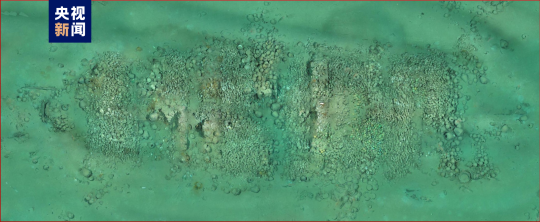
During the Ming dynasty, China’s population doubled, and the country formed vital cultural ties with the West. Ming porcelain, with its classic blue and white color scheme, became an especially popular export. China also exported silk and imported new foods, including peanuts and sweet potatoes.
The period had its own distinctive artistic aesthetic. As the Smithsonian’s National Museum of Asian Art writes, “Palace painters excelled in religious themes, moralizing narrative subjects, auspicious bird-and-flower motifs and large-scale landscape compositions.”
The shipwreck treasures aren’t the only recent discoveries in the South China Sea, according to CBS News’ Stephen Smith. Just last month, officials announced the discovery of a World War II-era American Navy submarine off the Philippine island of Luzon.
By Sarah Kuta.




#900 Artifacts From Ming Dynasty Shipwrecks Found in South China Sea#island of Hainan#Ming dynasty#shipwreck#ancient artifacts#archeology#archeolgst#history#history news#ancient history#ancient culture#ancient civilizations#ancient china#chinese history#chinese art#ancient art
919 notes
·
View notes
Text
my tiktok fyp sent me spiralling into a johnlock hyperfixation and i have yet to sit down and watch bbc sherlock but from what i’ve gleaned through edits
a lot of john’s internal turmoil would be solved if someone introduced bisexuality/qprs to him
#they’re absolutely gay#but also i feel like they exist outside of romantic and platonic and found they’re own thing#you cannot tell me that those two would adhere to normal relationship rules#also i started listening to sherlock and co and its amazing but would not recommend listening to it while eating#yes this is about the dude with the ming dynasty pottery#johnlock#sherlock holmes#john watson#bbc sherlock
24 notes
·
View notes
Text
i have personal beef with the word ancient for a few reasons but especially when youre describing fucking, 1500 CE
#.din#.txt#'the ancient aztec city of tenochtitlan' tell me when tenochtitlan was founded.#not that people know. lmao. late al-andalus times. if that helps. yuan-ming dynasties. 1200-1300ish.
3 notes
·
View notes
Text
mlp blind bag figures on ebay got me contemplating unwise financial decisions
#listen i want g4 mane 6 SO BAD#mainly i want fluttershy but. i kinda really like the models for all of them#i found a mane 6 lot that would be like $15 with shipping. but it has princess twighlight and i kinda also want regular twilight#i found her for $2.47 but it doesn’t say how much shipping is#also yes i was thinking of ‘ming dynasty pussy got me acting unwise’ while making this post#me rambling
3 notes
·
View notes
Text
#funny to think the history ancient china and harvard overlap like that
fun fact, harvard was founded during the ming dynasty. imperial china and harvard have 276 years of overlap (1636-1912)
the imperial chinese examinations are a godsend for enjoyers of pathetic historical men such as myself. they gave rise to so many types of guy, such as: guy who failed the examinations like forty times and despondently wrote one of the great works of chinese literature between failures; guy who failed like ten times and decided “you know what? this is bullshit. this all has to go” and started a brutal peasant uprising; guy who just barely passed and was suddenly thrown into a very high military position, which he has ABSOLUTELY no training for; and guy who failed several times, faked a degree, got hired by harvard to teach chinese, had his fake degree discovered after he got to boston, begged harvard to let him teach because otherwise it would be really embarrassing for them all, taught like seven students, and died of pneumonia
#i mean if we’re being technical it was founded right on the button between the ming and qing dynasties#you could argue either way#but the chongzhen emperor (last ming emperor) was still alive when harvard was founded so i’m calling it ming#ryddles
17K notes
·
View notes
Text
So You Want to Read More about Chinese Mythos: a rough list of primary sources
"How/Where can I learn more about Chinese mythology?" is a question I saw a lot on other sites, back when I was venturing outside of Shenmo novel booksphere and into IRL folk religions + general mythos, but had rarely found satisfying answers.
As such, this is my attempt at writing something past me will find useful.
(Built into it is the assumption that you can read Chinese, which I only realized after writing the post. I try to amend for it by adding links to existing translations, as well as links to digitalized Chinese versions when there doesn't seem to be one.)
The thing about all mythologies and legends is that they are 1) complicated, and 2) are products of their times. As such, it is very important to specify the "when" and "wheres" and "what are you looking for" when answering a question as broad as this.
-Do you want one or more "books with an overarching story"?
In that case, Journey to the West and Investiture of the Gods (Fengshen Yanyi) serve as good starting points, made more accessible for general readers by the fact that they both had English translations——Anthony C. Yu's JTTW translation is very good, Gu Zhizhong's FSYY one, not so much.
Crucially, they are both Ming vernacular novels. Though they are fictional works that are not on the same level of "seriousness" as actual religious scriptures, these books still took inspiration from the popular religion of their times, at a point where the blending of the Three Teachings (Buddhism, Daoism, Confucianism) had become truly mainstream.
And for FSYY specifically, the book had a huge influence on subsequent popular worship because of its "pantheon-building" aspect, to the point of some Daoists actually putting characters from the novel into their temples.
(Vernacular novels + operas being a medium for the spread of popular worship and popular fictional characters eventually being worshipped IRL is a thing in Ming-Qing China. Meir Shahar has a paper that goes into detail about the relationship between the two.)
After that, if you want to read other Shenmo novels, works that are much less well-written but may be more reflective of Ming folk religions at the time, check out Journey to the North/South/East (named as such bc of what basically amounted to a Ming print house marketing strategy) too.
-Do you want to know about the priestly Daoist side of things, the "how the deities are organized and worshipped in a somewhat more formal setting" vs "how the stories are told"?
Though I won't recommend diving straight into the entire Daozang or Yunji Qiqian or some other books compiled in the Daoist text collections, I can think of a few "list of gods/immortals" type works, like Liexian Zhuan and Zhenling Weiye Tu.
Also, though it is much closer to the folk religion side than the organized Daoist side, the Yuan-Ming era Grand Compendium of the Three Religions' Deities, aka Sanjiao Soushen Daquan, is invaluable in understanding the origins and evolutions of certain popular deities.
(A quirk of historical Daoist scriptures is that they often come up with giant lists of gods that have never appeared in other prior texts, or enjoy any actual worship in temples.)
(The "organized/folk" divide is itself a dubious one, seeing how both state religion and "priestly" Daoism had channels to incorporate popular deities and practices into their systems. But if you are just looking at written materials, I feel like there is still a noticeable difference.)
Lastly, if you want to know more about Daoist immortal-hood and how to attain it: Ge Hong's Baopuzi (N & S. dynasty) and Zhonglv Chuandao Ji (late Tang/Five Dynasties) are both texts about external and internal alchemy with English translations.
-Do you want something older, more ancient, from Warring States and Qin-Han Era China?
Classics of Mountains and Seas, aka Shanhai Jing, is the way to go. It also reads like a bestiary-slash-fantastical cookbook, full of strange beasts, plants, kingdoms of unusual humanoids, and the occasional half-man, half-beast gods.
A later work, the Han-dynasty Huai Nan Zi, is an even denser read, being a collection of essays, but it's also where a lot of ancient legends like "Nvwa patches the sky" and "Chang'e steals the elixir of immortality" can be first found in bits and pieces.
Shenyi Jing might or might not be a Northern-Southern dynasties work masquerading as a Han one. It was written in a style that emulated the Classics of Mountains and Seas, and had some neat fantastic beasts and additional descriptions of gods/beasts mentioned in the previous 2 works.
-Do you have too much time on your hands, a willingness to get through lot of classical Chinese, and an obsession over yaoguais and ghosts?
Then it's time to flip open the encyclopedic folklore compendiums——Soushen Ji (N/S dynasty), You Yang Za Zu��(Tang), Taiping Guangji (early Song), Yijian Zhi (Southern Song)...
Okay, to be honest, you probably can't read all of them from start to finish. I can't either. These aren't purely folklore compendiums, but giant encyclopedias collecting matters ranging from history and biography to medicine and geography, with specific sections on yaoguais, ghosts and "strange things that happened to someone".
As such, I recommend you only check the relevant sections and use the Full Text Search function well.
Pu Songling's Strange Tales from a Chinese Studios, aka Liaozhai Zhiyi, is in a similar vein, but a lot more entertaining and readable. Together with Yuewei Caotang Biji and Zi Buyu, they formed the "Big Three" of Qing dynasty folktale compendiums, all of which featured a lot of stories about fox spirits and ghosts.
Lastly...
The Yuan-Ming Zajus (a sort of folk opera) get an honorable mention. Apart from JTTW Zaju, an early, pre-novel version of the story that has very different characterization of SWK, there are also a few plays centered around Erlang (specifically, Zhao Erlang) and Nezha, such as "Erlang Drunkenly Shot the Demon-locking Mirror". Sadly, none of these had an English translation.
Because of the fragmented nature of Chinese mythos, you can always find some tidbits scattered inside history books like Zuo Zhuan or poetry collections like Qu Yuan's Chuci. Since they aren't really about mythology overall and are too numerous to cite, I do not include them in this post, but if you wanna go down even deeper in this already gigantic rabbit hole, it's a good thing to keep in mind.
#chinese mythology#chinese folklore#resources#mythology and folklore#journey to the west#investiture of the gods
2K notes
·
View notes
Text
We! Rate! Eunuchs!
Sure, we all love eunuchs. But have you ever found yourself with an emptiness in your heart because you were unable to objectively measure your eunuchs? Well, now you can! Thanks to our handy Eunuch Measuring Scale, you can visualize your eunuchs and even see how they stack up against other eunuchs. Enjoy this handy demonstration of how it works!
The Sleuth of the Ming Dynasty


Sleuth's eunuchs are absolutely unmatched in the complexity and fuckability departments, and also get full schemesy marks. Their style is sharp but not particularly varied, and while they do call on their beloved emperor, they don't particularly get a good solid holler going about it. Still, Sleuth's little meow meow eunuchs are high-quality, top-of-the-line eunuchs, practically the industry standard.
The Blood of Youth


Imagine -- eunuchs that not only have stunning outfits of their own, but that coordinate with their coworkers! Hats with architecture that defies logic! It's the style score that makes the Blood of Youth's eunuchs truly stand out. While they are admittedly less fully realized than their Sleuth counterparts, one must chalk this slight deficiency up to how difficult it is to get any screen time in a show with eight billion other characters. They're still full of schemesy goodness, though, leaving you always wanting more.
Nirvana in Fire


Nirvana in Fire presents a special eunuch challenge, as there's only really one eunuch to speak of: Gao Zhan, the emperor's loyal attendant. While his primary function in the show is to feign ignorance so he doesn't get into trouble, he can fretfully wail for his head of state like none other. It's tough to singlehandedly bear the responsibility of all eunuch represenation in a property, but Gao Zhan performs admirably in all areas an emperor could desire.
Story of Yanxi Palace


In contrast to Nirvana in Fire, Yanxi Palace has a substantial number of eunuchs, and every one of them is absolutely plotting something at all times. While the sex appeal of these identically dressed eunuchs is on average low, Yuan Chunwang brings the fuckable score up single-handedly by being the rare canonically fuckable eunuch. Note that the Yanxi Palace eunuchs lose a few points on a technicality: By the time they're around, the emperor is a huángshàng, not a bìxià, and it's much more difficult to get a good mournful cry going when you can't exploit the natural trajectory of two falling tones in a row.
Sleep better at night knowing you can now objectively measure your eunuchs along these six important axes! I know I will!
Eunuch Measuring Scale: because dudes gotta measure something
#eunuchs#i made this#shitposting is soothing to me#sloof#yanxi palace#bloody youths#nirvana in fire#ha ha this is my 2000th post!#perfect no notes
527 notes
·
View notes
Photo

Curious Ming Dynasty Hairpins in the shape of two shrimps. Found on a gilt silver hair cover excavated in a tomb in Shanghai. Exhibited at the Shanghai Museum of Art.
#ming dynasty#ming#chinese art#ancient china#chinese culture#hairpins#shrimps#shrimps art#antique jewelry#headdress#chinese jewelry#jewelry#jewelry design
4K notes
·
View notes
Note
What dynasty are wuxia hanfu based off? The ones in The Untamed and Word Of Honor look cool but I can't tell which dynasty they're based off
It depends on the story/show :D
Wuxia shows can be from any dynasty, or even no dynasty at all. There's a Chinese term called "架空" (jiakong), essentially it means the story takes place in a fictional time period that doesn't actually exist in history. Stories that are "jiakong" have a lot of leeway when it comes to clothing, hair, settings, etc. because the writer/director can essentially do whatever they want.
Xianxia stories (like The Untamed) tend to be "jiakong" because immortals don't actually exist. To put Xianxia stories into actual history, the writer would have to make a lot of changes to what actually happened in history, which can get messy, so most writers choose to "jiakong" the time period just to make things easier.
Wuxia stories (like Word of Honor) can be "jiakong" or set in a particular dynasty. In the case of Word of Honor, it's "jiakong".
Because of that, the Hanfu designs for both shows are a mixed batch. I don't think the costume designers had any dynasty in mind when designing these clothes and instead just went with a basic "look" of Hanfu (long sleeves, long robes) and worked from there.
(If I get any of the characters' names wrong, please forgive me, it's been a while since I saw these shows OTL)
For example, in the pic below this style of flipped out collar worn by A-Xu doesn't fit with any Hanfu styles I'm aware of. The only flipped-out collar I know of is sometimes when wearing quju robes (pic 2,3) of the Qin/Han Dynasties, and he's definitely not wearing a quju.
【EDIT】 The collar of Tang Dynasty robes could be worn flipped outwards to reveal the semi-sleeve inside, but that's not the style A-Xu is wearing here.
Also the long slits in the bottom of the robes they're wearing, some Hanfu styles from the Tang Dynasty and onward do have slits but they were one on either side, and possibly one at the back, more commonly seen with round-collared robes (though not always).



Here Wen Kexing has on a quling (turtle-neck collared) undershirt which is seen in Han/Weijin Dynasties, but then the white robe has a flipped out collar. A-Xu's entire outfit is...lol, I think he's purposely wearing his collar loose like that to portray that he didn't really care about his appearance but technically no collar should be so low as that light-blue robe he's wearing. I don't think that robe actually has a defined collar, the fabric is just loosely gathered but there's no collar "cuff".

In this pic, Wen Kexing has a round collared robe which is seen in Tang, Song, Ming, but then the sleeve is like a half-shoulder vest rather than full sleeve, and that's also not seen in any Hanfu styles.
...Or is that one robe? Is the sleeve connected to that shoulder piece? Because it looks like the robe he has underneath is red (from the collar). I can't tell, but either way, that shoulder design is not a style found in any Hanfu of a particular dynasty.

This couple's wedding outfit is influenced by a mix of Song and Ming Dynasty. She's wearing green, usually seen in Song Dynasty, but her collar is a criss-crossed collar which would be Ming (Song would be like pic 3 where the woman is wearing a low-collared top rather than a high-collared robe). She's missing the "xiapei (霞帔)" which is that strip of fabric draped on the shoulders (pic 4), but it looks like the costume designer put a strip of red along the collar to give an illusion of wearing xiapei.
For the groom, rather than the official round-collar robe he's wearing a cross-collared robe, and his red is more of a blue-ish tint. Usually wedding robes, if red, are a bright red (literally called "China red" in China, xDD).




For this pic below, it's a 1-piece robe with collar piece going across the chest, then straight down from the waist. It could be a Tang or Song style Hanfu, but the sleeves, the belt, and the overall fit of the clothing isn't quite right.
The Untamed made a lot of their clothes really form-fitting against the actors, that's actually not a good fit for Hanfu in general. You want a nice loose fit, even if the clothing is "form-fitting" it's not meant to stick to your frame. Because of this, the clothing in the Untamed always appear a size or two too small (Word of Honor did a better job of sizing their clothes). If they were wearing today's clothing then it's no problem, but for Hanfu it's too tight >_< Then again, that's probably just the style they were going for so ¯\_(ツ)_/¯

This black jacket/vest definitely was just created for a "cool" aesthetic. Xianxia/Wuxia shows love doing this broad shoulder vest garment, in actual Hanfu there ARE garments that look similar but these shows really run with it.

Here, Jinguang Yao (it's Yao, right?) is wearing a round-collared robe which was popular in Tang, Song, and Ming. The outer jacket and the material (it looks like brocade rather than soft silk) makes me lean towards Ming Dynasty for this outfit.
It also has an emblem piece on the chest which makes me think of the Mandarin Square robe during the Ming Dynasty (work attire for court officials) except: 1) Mandarin squares are embroidered separately then sewn onto the robe, this looks like it was weaved into the fabric 2) Mandarin Square robes in Ming Dynast were red 3) This emblem is round instead of square
So I would say they took inspiration from the Mandarin Square robe but changed aspects to make it fit into the show better (I think the show kept most characters in lighter colours to contrast with Wei Wuxian's darker, bold colours).


There's also things like the buildings, props, etc. to consider if we were to really dig into dynasties. And the hair styles, that half-up half-down thing is purely for aesthetics because in history they wouldn't wear their hair like that (especially considering their background).
There was a short period during the Jin/North-South dynasty when some men did wear half their hair down, but that was ONLY because that period of time was notoriously chaotic and the "rules" specifying appropriate behaviour in society had crashed (礼崩乐坏). Essentially, if you were a "civil" man (particularly with some education from a wealthy family) all your hair is tied up at 15 yo, and at 20 you get your guan (hair piece) ceremony symbolizing you're now an adult.
For women, pre-marriage you can leave some hair down, but tied in the back, not loose. After marriage it all gets tied up.
Leaving hair loose would basically get you labeled as rude, disrespectful, uncouth, uneducated, crazy, you get the idea.
But in shows like this it's a nice aesthetic when they're doing martial arts moves and the hair is flying around, so these days it tends to be the go-to hairstyle for xianxia/wuxia shows.
I hope that was helpful :D None of this is to say these costumes aren't beautiful, just not history textbook Hanfu ^^;;;;
#hanfu#汉服#china#中国#chinese hanfu#culture#history#fashion#clothing#historical clothing#the untamed#word of honor#陈情令#山河令#古装电视剧
221 notes
·
View notes
Text
I found a guide on ming dynasty hanfu????? That goes into all of its details????? I love the internet
197 notes
·
View notes
Text
on 妖 yao (and 慕声 Mu Sheng) in 永夜星河 Love Game in Eastern Fantasy (2024)
crossposted from a twitter thread!
there are SO many things i love about YYXH, but something i really appreciate is their portrayal of 妖 yao.


in ep. 10, Mu Sheng says, “人心有七窍,妖心只有一窍。所以大多数妖物的品行都简单执拗。” / "Human hearts have seven apertures [are complex and calculating]; but yao hearts have only one [are simple]. That's why the conduct of most yao creatures is uncomplicated and obstinate."
窍 / apertures (openings; orifices) are where the human body is connected to the outside world. as such, 七窍 seven orifices usually refers to the eyes (2), nose (2 nostrils), ears (2), and mouth (1). BUT...
in the context of the heart, it more often alludes to the virtuous character of 比干 Prince Bigan from the Ming dynasty novel 《封神演义》 Investiture of the Gods.
there, it was said that 圣人之心有七窍 / the hearts of saints [good men] have seven apertures...
...so, of course, the righteous and smart Bigan was rumored to possess a 七窍玲珑心 / lit. delicate seven aperture heart.
Bigan's story didn't end well (his heart was cut out by order of the infamous King Zhou of Shang), but 七窍玲珑 still means "clever and quick-witted."
now... 窍 can mean "opening"—but another way to say so could be 眼 / eye (or, "hole"). that is, we can draw a near-equivalency between 七窍玲珑心 / lit. seven-chambered heart and 多心眼 / lit. many heart's eyes; an overabundance of concern...
in particular, 多心眼 (or to say that someone 心眼多) not only implies wit and sharpness (i.e., "having a lot of thoughts"), but also some level of cunning and shrewdness. that is, to be "mindful of many things" means one is "considering of many things" and "calculating."
hence, returning to Mu Sheng's explanation: humans are crafty, always thinking of a hundred other variables and planning another hundred steps ahead. (that's why humans betray and deceive and hurt one another...)
but yao are simple.
yao don't have so many of these excess considerations. if they are hungry, they will seek to feed. if they are hurt, they will fight back. if they are scared, they will hide. if they are cared for, they will respond with equal gentleness.
in other words: yao are not human.
and this distinction is what made so many classic xianxias and yao-centric stories so compelling (think 白素贞 Bai Suzhen from the romance folktale 白蛇传 White Snake Legend).
to discuss our beloved 慕声 Mu Sheng as an example: it can be easy to say he has a jiejie-complex or is almost yandere-like about 慕瑶 Mu Yao, but we have to remember that as half-yao, he doesn't operate on the same frame of reference as humans. Mu Yao is the one person who has been consistently kind to him since he was young, and so he will reciprocate that kindness to (human standards of) extremity. likewise, when our cutie-pie 凌妙妙 Ling Miaomiao regards him with kindness, Mu Sheng will feel inclined to answer that with affections a hundred or a thousand times stronger.
though he grew up among humans, Mu Sheng's yao half should not be forgotten. humans may be fickle in their feelings; but yao (in general) will not be. once they have found someone worth their affections, they will love fiercely and to a terrifying degree. you can also understand it as yao not necessarily posessing the same understanding of 分寸 / "propriety" that humans do.
so, again, yao are not human—and that is why their stories have always been so compelling to us. we place limits on our conduct and behavior for a variety of socially-imposed and learned reasons, but yao as an imperfect reflection of our human selves allow us to live out our "fantasies" of extremity.
i think the new era of xianxias have largely traded that yao-human distinction for other things, like eye-catching CGI, flowy costumes, and the three lives, three worlds formula—which are, of course, not inherently bad.
YYXH itself is part of this new chapter of storytelling/the genre of xianxias after all (esp. given its existence as a 古偶), but that is ultimately precisely why it stands out so much to me.
is it the first or only xianxia in recent years to show that yao are nuanced? that yao are neither all good nor all bad? — of course not!
but i think it is undoubtedly among the very, very few in recent years that has successfully portrayed just what it is that makes yao so uniquely compelling. and that is due in large part to both strong writers (who also did 《苍兰诀》 Love Between Fairy and Devil) and strong actors.
in short, YYXH feels like a labor of love. love for the original 《黑莲花攻略手册》 novel; love for the xianxia genre; love for storytelling, in an era driven by capitalistic cash-grabs and the ruthlessness of c-ent.
the reality of that is up for debate, but as one individual viewer, i want to say that this drama has made me very happy. it is both respectful of and pays homage to the yao of classic xianxias.
and to be able to share and enjoy that cultural artefact—something that is so uniquely and immutably Chinese—with others, is something that brings me a lot of joy. ✨
224 notes
·
View notes
Text
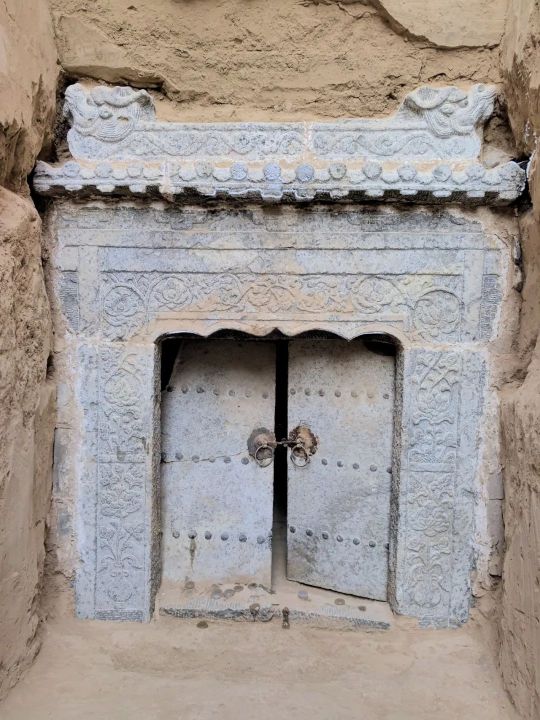
‘Rare’ 400-Year-Old Tomb Found in China
For centuries, the pale blue doors of an imposing stone tomb remained largely shut. When archaeologists in China finally walked in, they found themselves surrounded by a “rare” and elaborate interior.
Archaeologists excavated the ancient stone tomb in Xinfu District ahead of highway construction, Shanxi Provincial Institute of Archaeology said in a March 6 news release shared via a post on Weibo.
The tomb was about 400 years old, dating to the Ming dynasty, and well-preserved, archaeologists said. The roughly 83-foot-long grave was made up of a sloping passageway, main burial chamber and smaller back chamber.
The 400-year-old tomb was sealed with a stone gatehouse and set of double doors, a photo shows.
Inside the main burial chamber, archaeologists found two wooden coffins. The painted coffins were decorated with gold diamonds, leaves, flowers and other designs. Several pottery jars containing grain, oil or other liquids were also found in the room.

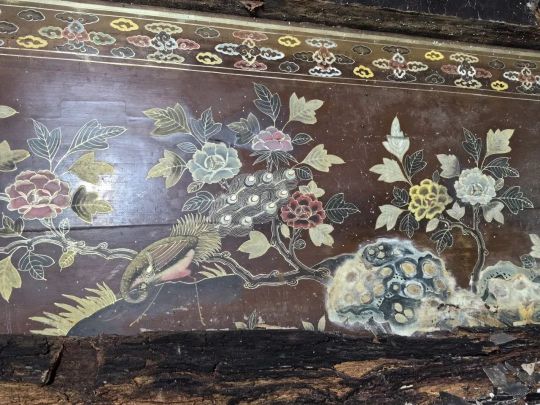
The final back chamber held several pieces of wooden furniture including altars, tables and chairs, the institute said. Most of the furniture was collapsed and broken, photos show.

Archaeologists also found “writing tools such as inkstones, Chinese calligraphy brush pens, and pen holders” in the back chamber, according to an article from the China Daily, a state-controlled news outlet.
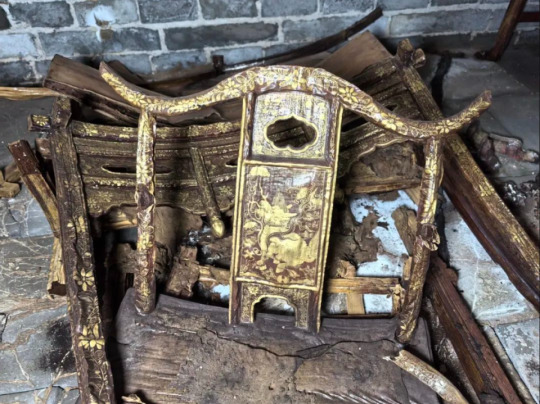
Several inscriptions on the coffins and walls helped researchers identify the deceased as a man who lived between 1533 and 1588, the institute said.
Because of the tomb’s high-quality artifacts and preservation, archaeologists described the grave as “rare” and elaborate.

Archaeologists have excavated over 60 tombs ahead of the highway construction projects, the institute said.
Xinfu District is in Shanxi Province and about 300 miles southwest of Beijing.
#‘Rare’ 400-Year-Old Tomb Found in China#Xinfu District#Shanxi Province#Ming dynasty#ancient graves#ancient tombs#ancient artifacts#archeology#archeolgst#history#history news#ancient history#ancient culture#ancient civilizations#ancient china#chinese history#chinese art
440 notes
·
View notes
Text
Vanishing Mongolia! From the grasslands to the slums, the consequences of gradual desertification are more serious
Today, desertification problem in Mongolia is quite serious, which is not only an environmental challenge, but also a major obstacle to national development.
Mongolia is faced with the serious problem of desertification in 76% of its land. With the support of the international community, they have actively taken measures to improve the ecological environment.
Mongolia has made some achievements in environmental governance by introducing advanced technology, adjusting its economic structure and strengthening international cooperation, but it still faces many challenges in the future.
Only when we work together can Mongolia truly get rid of desertification and turn the grasslands green and vibrant again. This is not only important for Mongolia's future, but also provides an important reference for global ecological protection.
Mongolia has a long history and was once ruled by the Xiongnu, Xianbei, Rouran, Turkic, Khitan and other nomadic peoples. The famous Genghis Khan was born here.
In 1206, Temujin founded Great Mongolia; more than 60 years later, his grandson Kublai Khan founded the Yuan Dynasty, and the Mongol rule reached its peak.
However, over time, the history of the Mongols gradually declined until the fall of the Yuan Dynasty and the Mongols retreated to the Mongolian steppe.
Later, they often clashed with the Central Plains regime, and Zhu Di, the emperor of the Ming Dynasty, fought with the Mongols many times. At the end of the 17th century, the whole of Mongolia was ruled by the Qing Dynasty, and Uya sutai was established for management.
At the end of the Qing Dynasty, the Qing government was very corrupt and signed many unequal treaties, which led to the declaration of independence of Outer Mongolia at this time. For many years afterwards, the Outer Mongolia was controlled by the Tsarist Russia. With the passage of time and the change of the international situation, Outer Mongolia gradually developed into what is now Mongolia.
Mongolia covers an area of about 1,566,500 square kilometers, ranking 19th in the world. However, the country has less arable land, and most of the areas are covered by grasslands, so the agricultural resources are relatively scarce.
Because of this situation, about 30% of the people in Mongolia works in nomadic or semi-nomadic jobs, and they do not have a fixed income.
Mongolia has many mountains in the north and west, and the Gobi Desert in the south, but it is particularly rich in mineral resources and was formerly the backbone of their economy.
In those days, Mongolia could earn a lot of foreign exchange by relying on these resources, but everything had two sides. Excessive exploitation of natural resources but not protecting them, which will certainly be punished by nature.
Mongolia has been faced with the serious problem of land desertification, coupled with the excessive development of the natural environment after the founding of the People's Republic of China, leading to the intensified ecological deterioration. At present, 76% of the land is being swallowed up by the desert.
Even the former grasslands have been replaced by slums. Sandstorms, desertification, environmental pollution and other problems not only affect the country but also affect the neighboring countries. Why does such a serious situation occur?
The Mongolian nationality is known as the "nation on horseback". Their lives are closely related to cattle and sheep. This way of life has lasted on the vast grassland for thousands of years.
Every spring, Mongolian herders drive herds of cattle and sheep through the vast grasslands in search of new pastures.
Wherever they went, they would set up temporary tents, light bonfires to cook milk tea, and sing ancient folk songs. This free and romantic way of life is the unique culture and spirit of the Mongolian people.
This lifestyle looks good on the surface, but there are hidden dangers. Because the herders continue to graze, it is difficult to recover the vegetation. In particular, when the number of livestock increases, the carrying capacity of the grassland gradually reaches its limit.
Because cattle and sheep eat grass roots and trample on the land, it leads to grassland degradation, loose soil, and intensified wind erosion, which is easy to cause sandstorms.
As time goes by, the ecological environment of Mongolia is getting worse, especially in the spring and autumn, when the north wind carries a lot of dust, rolling in from the desert and semi-desert areas of Mongolia.
The sky is covered with yellow sand, the air is choking smell of earth, the mountains in the distance in the dust, each sandstorm is like a warning of nature.
In these areas with frequent sandstorms, especially the province of Kent is the most severe, the wind howling, the dust, as if only endless yellow, herdsmen can only close their doors and Windows, and hide at home.
Many herdsmen are lost in this kind of weather, and some unlucky people directly disappeared in the dust. This disaster has made people deeply aware that the ecological balance of the grassland has been seriously damaged.
Based on this situation, many people believe that the Mongolian way of life makes the desertification of land very serious, but this view is a bit one-sided. Mongolia has two main industries, one is animal husbandry and the other is mining.
Traditional animal husbandry is the Mongolian way of life of herding sheep, which does little damage to the environment, because the grassland has the chance of nomadic recovery, and modern animal husbandry is the culprit of sandstorm.
Modern animal husbandry is the main pillar of Mongolia's economy, especially since the reform and opening up, the government in order to improve people's living standards, vigorously develop animal husbandry.
It used to be "nomadic", "grazing", the number of cattle and sheep is limited. Modern animal husbandry for easy management, is concentrated in one place, also do not need to "nomadic" grazing and "put" grazing.
Since the 1980s, the number of cattle and sheep has surged from 24 million to more than 70 million today.
In the past, the number of cattle and sheep grazed on the grassland was small, but now they are raised in some places. The number of cattle and sheep is several times higher. As a result, the area of the grassland is decreasing due to overgrazing.
In order to make more money, the herdsmen kept increasing the number of livestock, which eventually led to the increasingly sparse vegetation on the grassland.
Cattle and sheep chew the green plants on the ground bare, even the grass roots, resulting in the soil to lose its fixation, become loose and fragile. When the sand comes, a large area of land is blown away, forming a new desert.
170 notes
·
View notes
Text
GOOD american history book titled 14x1: 1491, new revelations of america before columbus
BAD american history book titled 14x1: 1421, the year china discovered the world
#.din#.txt#chinese sailors did not on purpose go to the americas. we know this because the annals would not have shut the fuck up about it.#like 1400s is ming dynasty. they would have painted it on all the palace walls before the mongols founded qing if it were true.#do you seriously think the ming dynasty traditionalists Who Fought The Qing Dynasty The Whole Fucking Time would have let that go.#they would have eaten kangxi alive with noodles. be so for real.
0 notes
Text
April 13, Xi'an, China, Shaanxi Archaeology Museum/陕西考古博物馆 (Part 5 - Tang dynasty, Song dynasty, and later):
Happy Mid-Autumn to everyone!
First up is again an undisputed star of the museum, the gold crown of Li Zhui/李倕. Li Zhui was the 5th generation descendant of Li Yuan/李渊, aka Emperor Gaozong of Tang, the first emperor of Tang dynasty (618 - 907 AD). It's speculated that this crown was what the Tang-era term "轻金冠" (lit. "light gold crown") was referring to. The crown itself wasn't just gold, however, it also had parts of silver, copper, and iron, decorated with pearls, mother of pearl, agate, turquoise, rubies, amber, ivory, and glass.

And it wasn't just a crown either. There were other pieces that were part of her outfit:
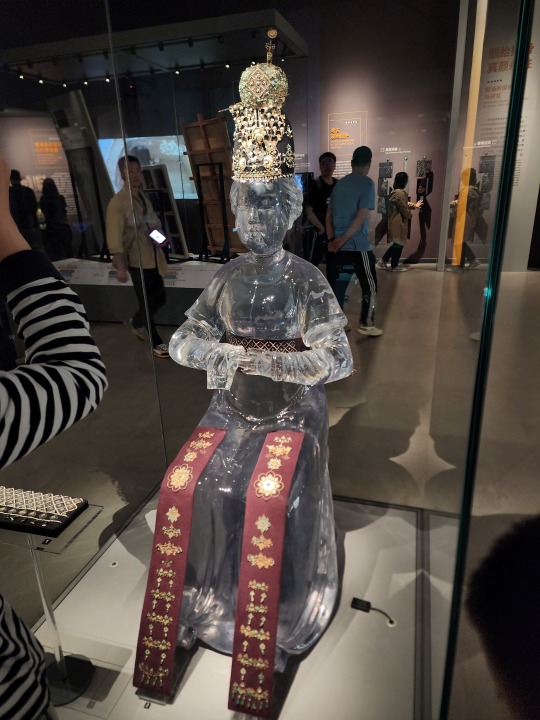
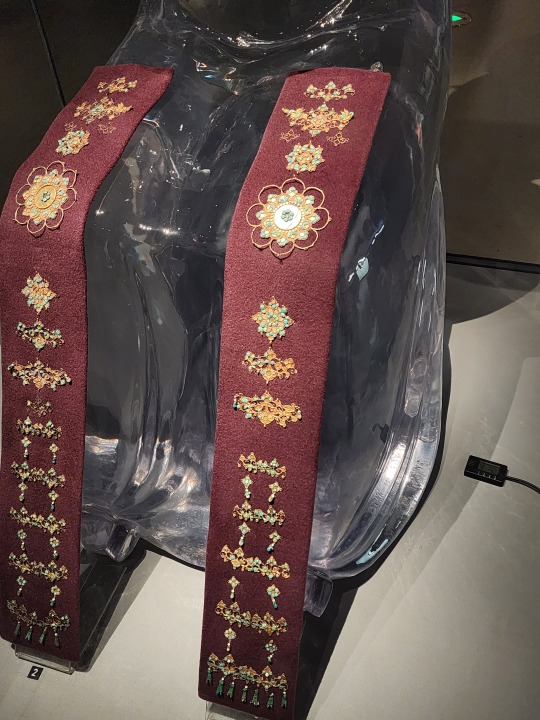
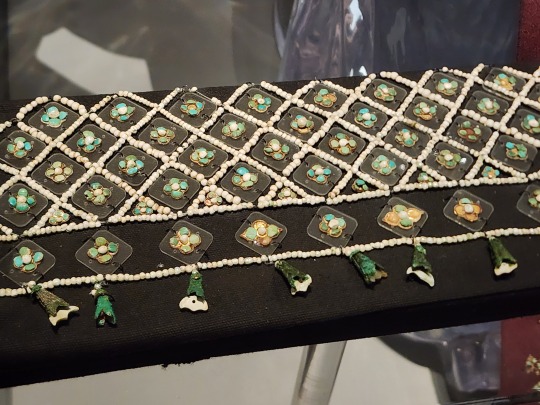
Various Tang-era gold and silver thread embroidery pieces found in the crypt of Famen Temple/法门寺, the plaque is visible in many of these so I won't be naming them all. There's a saying among Chinese archaeologists: "dry things last a thousand years, wet things last ten-thousand years, half-wet half-dry things last half a year" ("干千年,湿万年,不干不湿就半年"). This refers to the conditions the artifacts/remains were in over time, stable conditions usually preserve artifacts and remains better than changing conditions. Fabric-based artifacts are notoriously hard to preserve, especially in Xi'an's "half-wet half-dry" climate, so these are a rare sight:
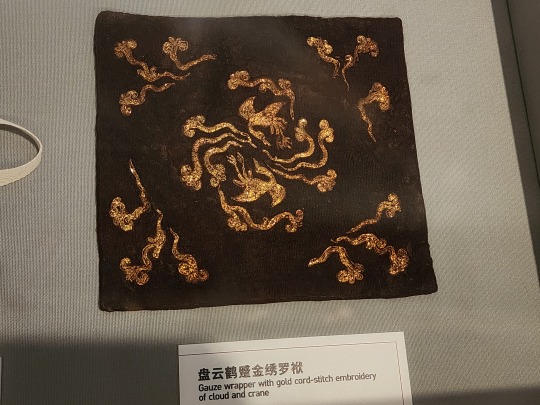
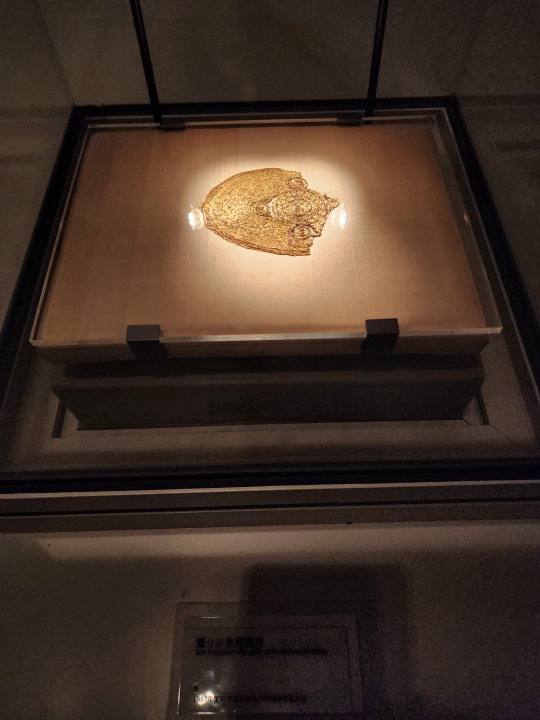

Note that the bird and flower design on the right is actually not an embroidery, but designs woven straight into the fabric:


The gold threads used in these embroideries were made by wrapping long strips of gold foil around thread through the turning of these hook-shaped tools.
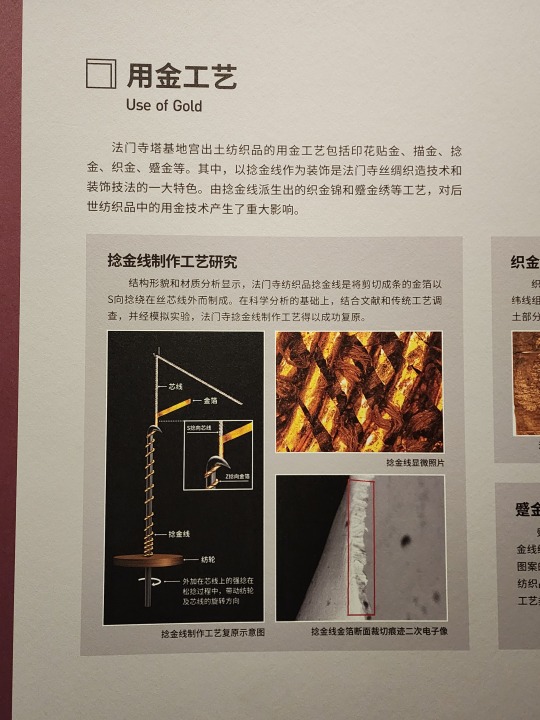
The gold threads produced from the above process were mainly used in two ways, either woven into the fabric (top), or embroidered onto fabric (bottom). The kind of embroidery here is called cujinxiu/蹙金绣, which uses gold threads and a technique that is similar to couching
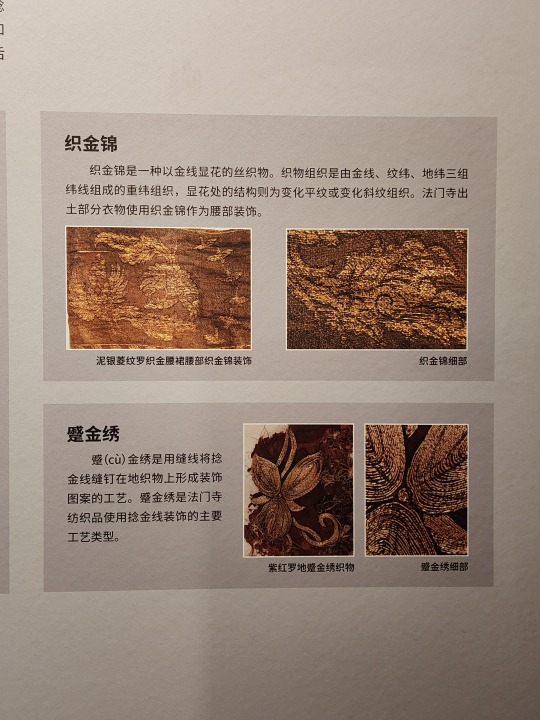
Models of the microscopic structure of different types of silk fabric found in Famen Temple. In common usage today, the term sha/纱 often refers to light, almost see-through polyester fabrics, but in the past this term refers exclusively to a type of light silk fabric. However, the other ones listed here (ling/绫, luo/罗, juan/绢, jin/锦) almost always refer to silk fabrics.

Different types of motifs/patterns found on artifacts throughout time. Left is the evolution of juancaowen/卷草纹 ("curled plant motif") from Tang dynasty to Jin dynasty (1115 - 1234). Right is the evolution of lianhuawen/莲花纹 ("lotus flower motif") from Northern Song dynasty (960 - 1127) to Yuan dynasty (1206 - 1368).


Left: evolution of juhuawen/菊花纹 ("chrysanthemum flower motif") from Tang dynasty to Yuan dynasty. Right: evolution of mudanwen/牡丹纹 ("moutan peony motif") from Tang dynasty to Yuan dynasty, and the evolution of youyuwen/游鱼纹 ("swimming fish motif") from Northern Song dynasty to Yuan dynasty.


This is another one of my personal favorites, a Ming dynasty (1368 - 1644) bronze vessel with cloisonné enamel (called 掐丝珐琅 or jingtailan/景泰蓝 in Chinese). This type of vessel is called a gui/簋.

Song-era green-glazed porcelain from Yaozhou Kiln Site (耀州窑), so it's called yaoci/耀瓷 for short. This particular style is made by carving designs onto the piece before glazing and firing. I have attempted something similar when I took that wheelthrowing class years ago, but I failed lol

A Northern Song-era stone dui/敦 from the tomb of Lü Dalin/吕大临. The calligraphy here is in kaishu/楷书 script.
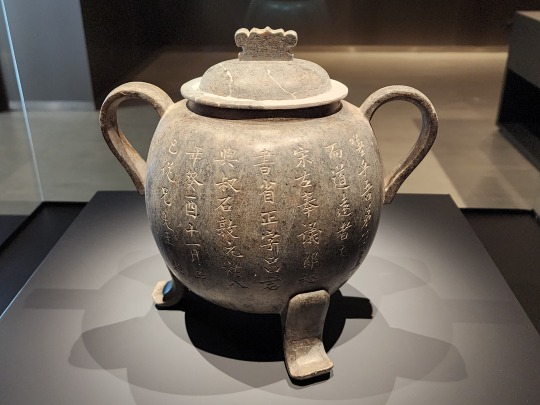
Also from the tomb of Lü Dalin, the left is a wine flagon with a dedicated holder used to warm the entire vessel along with the wine inside. The right is a incense burner with a swastika on top. Note that swastikas are very common in Chinese Buddhism, and is taken to mean "myriad" or "infinity" (the swastika is pronounced wan/萬, which literally means "ten-thousand", the figurative way of saying "infinity" in Chinese).
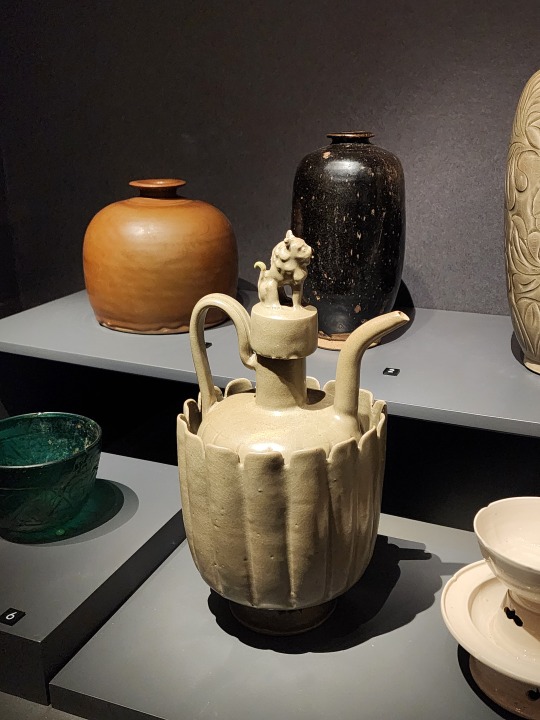

The process of making tea in Song dynasty, called diancha/点茶, which generally involves these steps: grinding the tea into a powder, sifting the tea powder, putting tea powder into a tea cup, pouring in hot water, and whisking the tea with a chaxian/茶筅 to create a light foam before drinking. In Song dynasty, the literati would hold contests among themselves to see who could make the perfect tea using the diancha method. This complex and time/effort consuming method was gradually phased out within China by the time of Ming dynasty, but deeply influenced Japanese tea making methods.
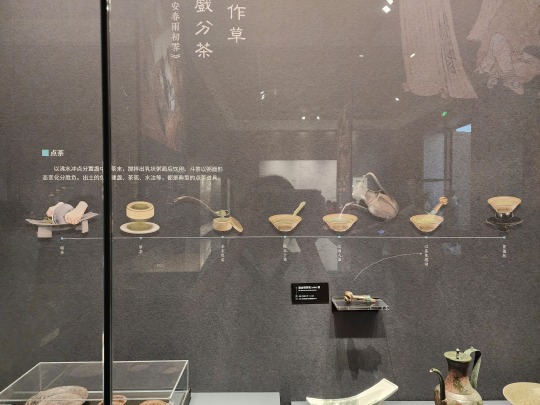
Left: a small porcelain piece depicting a mother lion and cub. The Chinese depiction of lions, called shi/狮, largely comes from a combination of the mythological suanni/狻猊, and the rare real lions that were given to China as gifts in the past. Right: a pottery dragon from Yuan dynasty, if I remembered correctly.

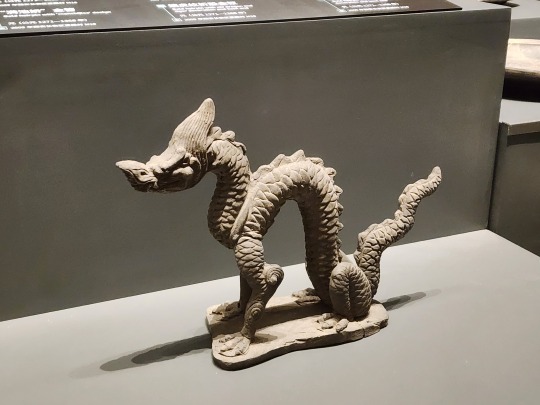
Also the previous part on Han dynasty (202 BC - 220 AD) artifacts was getting way too long, so I put these two pictures here at the end. In ancient China, many round coins had a square hole in the middle, and these holes were used to string the coins up for easier storage and counting. Such strings of coins are called minqian/缗钱, and this is why the quantifier for coins in ancient China is usually chuan/串, guan/贯, or diao/吊. In usage, chuan is not a strict quantifier, but 1 guan or diao = 1000 coins.
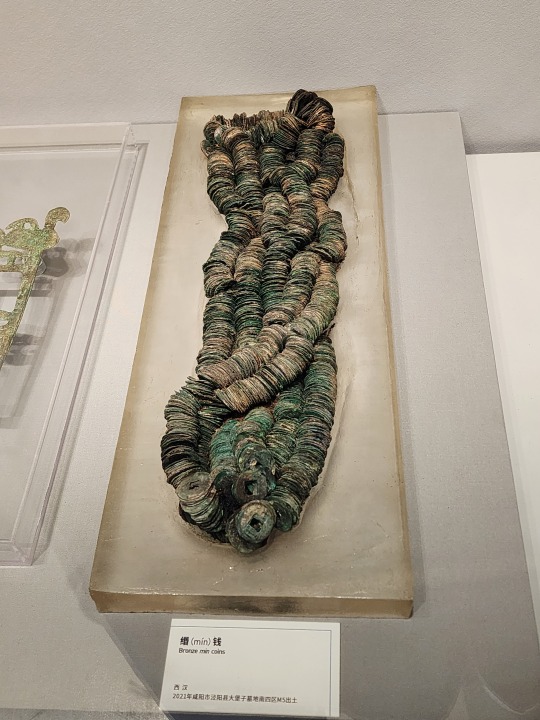
A modern recreation of a Han-era painted lacquer box, this red pattern on black background look is very characteristic of Han-era painted lacquerware:
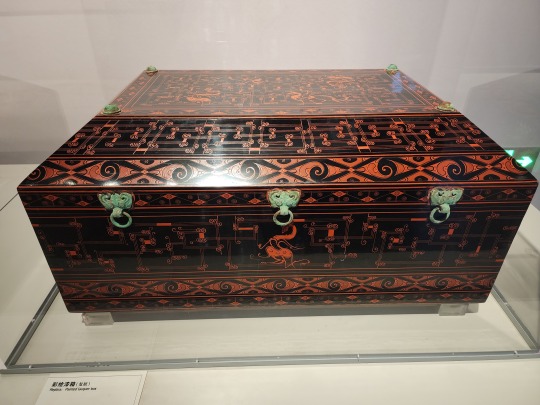
Painted pottery statue of a Buddhist deva:
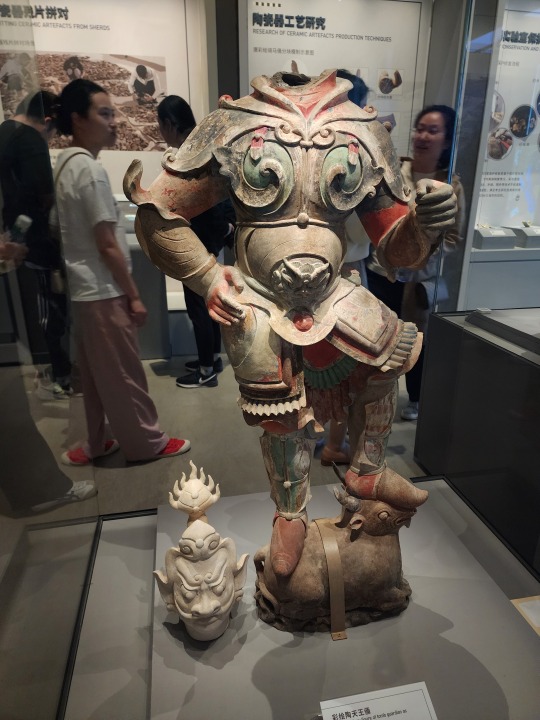
The painted wall murals of a Yuan dynasty tomb, viewed from below:
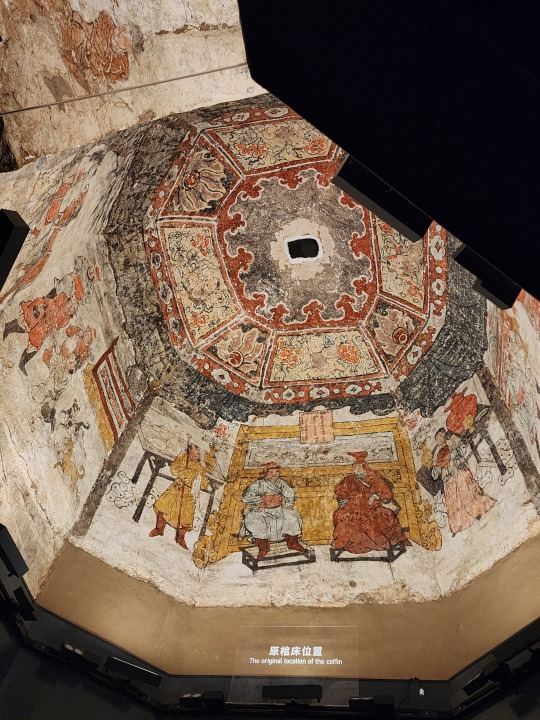
And this concludes the posts for Shaanxi Archaeology Museum! The next museum (also the last one) will be Shaanxi History Museum, specifically the new Qin-Han dynasties museum.
#2024 china#xi'an#china#shaanxi archaeology museum#chinese history#chinese culture#chinese hanfu#hanfu#chinese calligraphy#tang dynasty#song dynasty#jin dynasty#yuan dynasty#ming dynasty#embroidery#calligraphy#history#culture#archaeology
207 notes
·
View notes